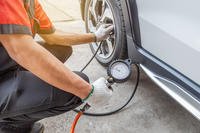Cars. When talking with people having financial difficulties, well over half of the cases are caused by, or made worse, by excessive borrowing for a car, or problems with a car lease.
Sometimes, these are well-thought out foolish choices, but it’s usually just a lack of knowledge leading to poor decision making. I've made my share of poor car-buying decisions, and maybe I can help someone avoid the same poor choices.
Dear Kate,
My wife and I just found out we are expecting a baby - our third. Neither of our cars can hold three car seats, so we’ll have to get a new car. BUT, we’re underwater on the car we’ll be getting rid of. We still owe $12,000 on it, and it’s only worth about $8,000. We have talked to a dealer and they are willing to take care of the $4,000 balance if we buy a new car with them. My dad says it’s a bad idea, but can’t tell me why. Can you?
Brian
Oh, there’s so much to deal with here. I’m glad Brian’s dad has him thinking in the right direction. Let's see if I can add to the conversation.
Dear Brian,
Congratulations on your new addition. I have been in your exact same place - underwater car loan and baby #3 on the way. It was a sobering realization that even our 0% car loan had a downside. Fortunately, there are a lot of different ways to solve this problem.
I agree with your dad. Taking the amount you are underwater on your current car, and putting it into a new car, is called “rolling over negative equity.” It’s pretty common: Edmunds.com reports that 30% of trade-in involved rolling over an average $4,502 in negative equity. But common doesn’t mean that it is the best choice.
When you roll over negative equity into a new loan, you’ll add the amount you owe from the last car to the amount you owe from the new car. There are a couple of accounting tricks to make this happen. The most common way is to inflate the trade-in price of the car you’re trading in, and then inflate the price of the new car by the same amount. So, let’s say you traded-in your car that should reasonably be worth around $8,000. The dealer would give you the full $12,000 for the trade in, paying off your previous loan, but increase the sales price of the new car by the $4,000 difference.
Now, let’s say that car you are buying should cost $25,000. Add that $4,000 premium, and you’re now paying $29,000 for a $25,000 car. If you finance that over 5 (ack!) years, even at a promotional 1.9% interest rate, you’ll pay an extra $70 per month on that new car loan because of the negative equity you’ve rolled over. Worse, you’ll be underwater on that new car for even longer than usual, because you’ve got that extra $4,000 to overcome. If you don’t stop this cycle, you’ll just end up further and further underwater on each new car, with the debt growing and growing.
You may know that I generally try to avoid telling people what to do, but rather just providing education so that you can make your own smart decisions. But I’m pretty much going to tell you NOT to roll over the negative equity into a new car.
So, what are your options? I’m going to assume that you don’t have the $4,000 to make up the difference and you don’t have any down-payment or other savings for a new car purchase.
Keep The Car You Have
In most cases, the best way to deal with an underwater vehicle is to keep it and pay it off as quickly as possible. This might not be possible for you, but let's at least consider it.
Are you absolutely sure that you can not fit three car seats into either of your current cars? It will probably require buying all new carseats, but that is OK. Carseats are cheaper than cars. There are websites and Facebook groups devoted to figuring out which carseats will fit into which cars, and how to configure them based upon the ages and relative self-sufficiency of your children. This was our solution; we were able to find three narrow profile car seats to put across the back seat of our car. Total cost was less than $600, which was a lot better than delving into car shopping. Look for both of your current vehicles - swapping “main” cars might be a better solution than purchasing.
Use The Time You Have
Presumably, you have a few months between now and when the baby is coming. Buckle down and figure out how to save or earn as much of that $4,000 as you can. Sell stuff you don’t need, get a part-time or seasonal job, or do some dog-sitting on the side. Put of the next steps for a few months to get yourself better positioned to move forward. You should be able to use these funds to make principal payments against the existing car loan, also decreasing the amount of interest you are paying. Maybe you can even pay off that $4,000 and come up with a little down payment on your new purchase! (I'm a dreamer, but sometimes dreaming pays off!)
Sell Strategically
Figure out which one of your current cars is going to give you the least shortfall when you sell. It may not be the one you want to sell, but it’s a smarter choice. Take a little extra time to make the most from your old car as possible. Give it a good wash and a thorough clean to help it shine. This will help reduce the amount you’re short.
Selling it privately typically yields the most money. The only problem with a private sale when you have a loan is that it can be a little tricky, and it can make car buyers uncomfortable. But it can be done. Talk to your current loan holder now to thoroughly understand the process so you can make it as easy as possible for the buyer.
Borrow The Difference
Get a loan to cover the amount remaining on your loan after you apply the proceeds of your car sale. You can take out a loan from your credit union, or from a kindly and willing friend or family member. Some lenders will allow you to take the remaining balance from your car loan and just convert the terms to a personal loan. The interest rate will be higher than the car loan, but that’s OK because you’re going to make every effort to pay it off as soon as physically possible. Be sure the loan doesn’t have any sort of pre-payment penalty.
If considering borrowing from a person, be sure to your personal situation, and feel entirely comfortable that it won’t interfere with your personal relationship. Be sure to pay them back on schedule, and earlier if possible.
Pick Your Replacement Vehicle
Buy an inexpensive used car to replace the car for which you’re underwater. Inexpensive does not have to mean unsafe for your family! Again, buying privately is typically the most affordable, but also the most challenging. Separately, search out the best possible loan you can find for this new car. Ideally, that means a shorter term, but it has to be manageable. Credit unions typically have very competitive rates and terms.
Move Forward
In a perfect world, the total payments of your personal loan and your new car loan will be less than the car payment on your old car loan, but maybe not. Either way, try to pay them off quickly, starting with the personal loan. Try to get out of the cycle of car loans!
I could continue to write forever about what you should do in steps 6 through 12, but that’s probably way more than you were asking.
Hopefully, this all sounds like something you can do. If it doesn’t, let me know which step is holding you up and we’ll explore some work-arounds. You don’t need the added stress of a further-underwater car loan when you’ll be juggling three kids!
Kate
Two of the three times I made a poor car buying choice, I was pregnant and wasn’t able to see past the immediate need and desire for safe transportation. It's a perfect storm of emotions, needs, and wanting the best for your babies. They were expensive mistakes, and I would be so thrilled if anyone could learn from them.









